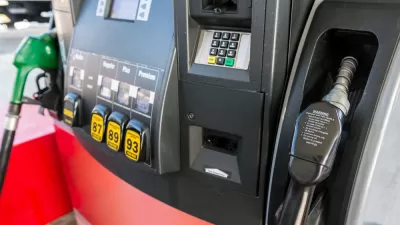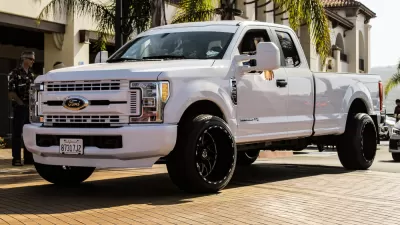Several key factors, not the least of which was cheap gas, combined to make 2015 a record year for new passenger vehicle sales, smashing the 2009 record of 10.4 million sales and edging-out the prior record of 17.40 million sales in 2000.
Other than the record number of vehicles sold, 17.5 million, what is most notable about 2015 sales is the changing composition of the American passenger vehicle fleet. As the caption under the accompanying graphic states, "car sales remained relatively flat, about 1 million more light trucks and SUVs were wold in 2015, a 13 percent jump from 2014." See below for more precise data.
"But because so much of buyers’ money went toward larger, gas-gulping trucks and SUVs, the sales boom conflicts with (an) administration campaign designed to encourage more efficient engines and less use of gasoline," write Drew Harwell and Steven Mufson for The Washington Post.
(T)he average fuel efficiency of new vehicles sold declined in 2015 to 25 miles a gallon, and U.S. consumption of gasoline rose 3 percent in 2015. [See related post.]
Increased SUV sales may imperil meeting President Obama's fuel efficiency goal—54.5 mpg by 2025.
Sales of slimmer passenger cars fell 2 percent last year compared with 2014, while sales of light trucks and SUVs soared 13 percent, estimates from industry researcher Autodata show.
It could have been worse. Unlike 2000, when larger SUVs like the Ford Explorer were best-sellers, Americans chose lighter SUVs like the Honda CR-V, which now compose the largest segment of the market at 14 percent, according to The Associated Press. While more fuel efficient than other light truck types (SUVs, pickup trucks and vans weighing <10,000 pounds per U.S. DOT [pdf]), these models are nonetheless displacing more fuel efficient subcompacts, compacts, hybrids, and electric vehicles.
According to AP, electric vehicle (EV) sales plummeted. The world's best-selling EV, the Nissan Leaf, saw U.S. sales drop 43 percent to "17,269, down from 30,200," from 2014, reports Auto Blog.
However, all was not bad for EV sales. "Tesla sold more than 50,000 Model S sedans in 2015, a new annual record," reports BGR.com.
As for those bike and transit-riding, Uber-using millennials living in dense cities who have no use for owning automobiles, they are now causing a "demographic shift" in auto sales, states the moderator in her video interview of TrueCar's Eric Lyman, who indicates that they are now a key driver in auto-sales.
Finally, most auto manufacturers reported record sales. One notable exception was Volkswagen, due to the "defeat device" scandal that is now the subject of a civil complaint filed by U.S. Department of Justice. AFP reports that their U.S. sales fell 5 percent in 2015, not bad considering the "25 percent drop registered in November after VW stopped selling diesel vehicles shown to have been equipped for years with software that intentionally subverted clean-air regulations."
FULL STORY: U.S. car sales hit record high in 2015

Study: Maui’s Plan to Convert Vacation Rentals to Long-Term Housing Could Cause Nearly $1 Billion Economic Loss
The plan would reduce visitor accommodation by 25,% resulting in 1,900 jobs lost.

Alabama: Trump Terminates Settlements for Black Communities Harmed By Raw Sewage
Trump deemed the landmark civil rights agreement “illegal DEI and environmental justice policy.”

Why Should We Subsidize Public Transportation?
Many public transit agencies face financial stress due to rising costs, declining fare revenue, and declining subsidies. Transit advocates must provide a strong business case for increasing public transit funding.

Paris Bike Boom Leads to Steep Drop in Air Pollution
The French city’s air quality has improved dramatically in the past 20 years, coinciding with a growth in cycling.

Why Housing Costs More to Build in California Than in Texas
Hard costs like labor and materials combined with ‘soft’ costs such as permitting make building in the San Francisco Bay Area almost three times as costly as in Texas cities.

San Diego County Sees a Rise in Urban Coyotes
San Diego County experiences a rise in urban coyotes, as sightings become prevalent throughout its urban neighbourhoods and surrounding areas.
Urban Design for Planners 1: Software Tools
This six-course series explores essential urban design concepts using open source software and equips planners with the tools they need to participate fully in the urban design process.
Planning for Universal Design
Learn the tools for implementing Universal Design in planning regulations.
Smith Gee Studio
Alamo Area Metropolitan Planning Organization
City of Santa Clarita
Institute for Housing and Urban Development Studies (IHS)
City of Grandview
Harvard GSD Executive Education
Toledo-Lucas County Plan Commissions
Salt Lake City
NYU Wagner Graduate School of Public Service




























